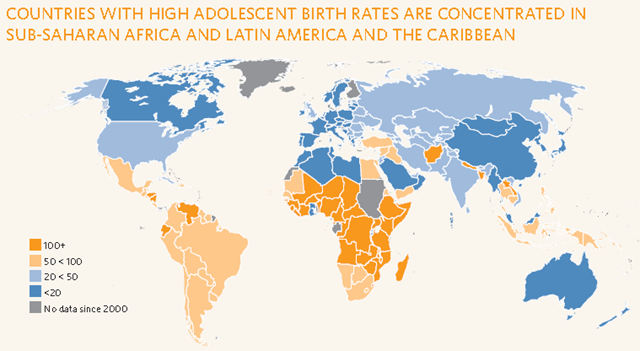Graph of the Day: Adolescent Birth Rates By Country
In Ethiopia, a low-income country with 39 per cent of its 82.9 million people living below the international poverty line of $1.25 a day, according to the World Bank, hardship rather than rising expectations and better living standards may be the major factor in motivating young women and men in cities when family choices are made. Assefa Hailemariam, the former director of the Population Studies and Research Centre at Addis Ababa University’s Institute of Development Studies, said that young urbanites are bringing fertility rates down very fast for economic reasons. “Urban life is demanding,” Hailemariam said. “You can’t count on relatives to look after your kids. You can’t have too many—bringing them up, taking care of them. Also urban people have access to communications [media] so they are aware that having a smaller number of kids is better for their future—you can educate your children, buy them clothing and so on.” Nationally, Ethiopia’s fertility rate has been 3.8 for the period of 2010–2015. In Addis Ababa, the capital, Hailemariam said, the rate has fallen below 1.5. “In 2000 it was 1.9 or so; now we expect that it would be much lower,” he said. “This is not necessarily just because of contraceptive use, although contraceptive use has played a role, but because of a number of development issues—a higher age of marriage in Addis, education, health improvement, contraceptive access.” Very young herself, Amsalu Buke, who brings family planning to outlying Ethiopian communities where access is limited, has become an astute observer of the lives of girls in their teens and younger. In her four years at her post in the village of Tare, she said, she has seen child marriages declining. “Thirteen and 14 year olds used to marry,” she said. “Now because of advocacy by local women’s organizations, the practice is disappearing.” Ethiopia, where half the girls are married by age 18, is one of several countries where child marriages—which effectively end a girl’s chances of education and may destroy her health or end her life—are declining, according to UNFPA and the Population Reference Bureau, an independent research organization in the United States. But in the Amhara region and some other parts of Ethiopia, the practice remains a stubborn problem and continues to rob girls and young women of their rights, education and health. Of the ten countries with the highest child marriage rates, according to the Population Reference Bureau’s 2011 survey, Who Speaks for Me? Ending Child Marriage, eight are in Africa, and Niger is at the top, with three-quarters of girls married before the age of 18. The remaining two countries outside that region are Nepal, where 7 per cent of girls are married by age 10 and 40 per cent by age 15, and Bangladesh. Several states in India also rank high in child marriages. In India, the Centre for Health, Education, Training and Nutrition Awareness, a non-governmental organization based in the state of Gujarat, battles widespread anemia among girls, which weakens them and contributes to an estimated 6,000 deaths in adolescent pregnancies annually, many because of early marriage, according to a recent report by Swapna Majumdar of Women’s eNews. “Child marriage undermines nearly every Millennium Development Goal; it is an obstacle to eradicating poverty, achieving universal primary education, promoting gender equality, improving maternal and child health and reducing HIV and AIDS,” the Population Reference Bureau survey says. It adds that because young girls are often married to older men who may have
had numerous sexual partners, their chances of HIV infection are greater than those of unmarried sexually active girls. Forcing a child into marriage for any reason is a violation of the Convention on the Elimination of All Forms of Discrimination Against Women and the Convention on the Rights of the Child. Gender inequality is an underlying cause of child marriage, says UNFPA gender expert Gayle Nelson. “And without addressing this issue, it will be impossible to eradicate this or other discriminatory harmful practices.” In Mozambique, the balance of power in a relationship in favour of the man is tipped even further by early marriage, which also chips away at a young woman’s right to determine her own reproductive destiny and often resulting in early and numerous pregnancies. A young woman’s decision-making power may be additionally diluted in polygamous settings, in which about one in four Mozambican women is involved. According to a study by Mozambique’s National Statistics Institute, more than half of women between ages 20 and 49 say they were married before the age of 18, and about one in five say they married before age 15. In Mozambique as in many other countries, early marriage is more common among girls with little or no formal education. The Government of Mozambique outlawed marriage before the age of 16, and since 2004 when a new Family Law went into effect, a child may not marry before reaching 18 without parental consent, which is often granted by fathers who are eager to have their daughters marry as early as possible. Furthermore, the law is difficult to enforce, particularly in remote areas. And the law can do nothing to stop girls from entering into a relationship outside of marriage. About two in five women who are married or in a partnership are involved with men who are 10 or more years older than they are. A report from UNFPA and the Population Council in 2003 describes the “demographic consequence” of child marriage: short spans between generations and population growth. “The bride’s young age, often combined with the older age of her partner, intensifies power differentials in the relationship,” the report states. “Her young age is indicative of a relatively low level of education. Her lack of knowledge and skills may make her more reliant on high numbers of children for security with the marriage, as well as long-term social security.”
